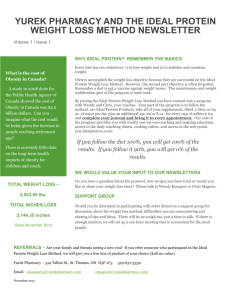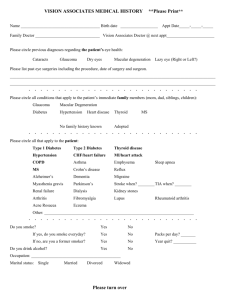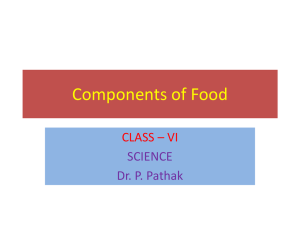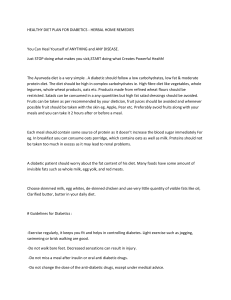Eye Examinations and Nutrients
advertisement
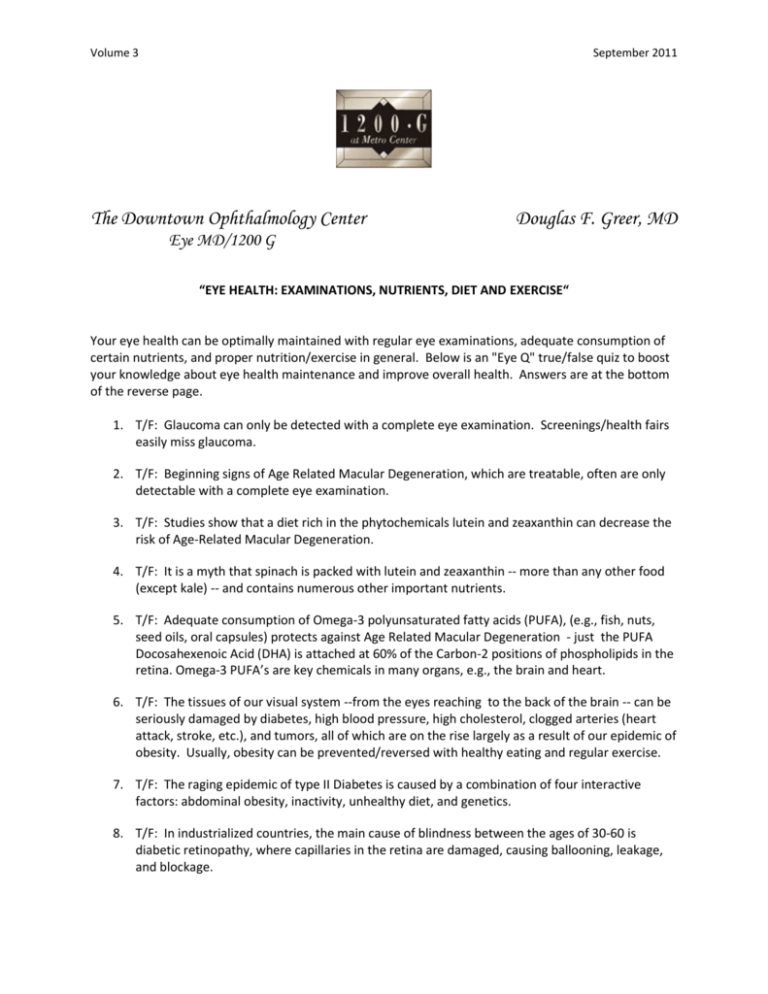
Volume 3 September 2011 The Downtown Ophthalmology Center Douglas F. Greer, MD Eye MD/1200 G “EYE HEALTH: EXAMINATIONS, NUTRIENTS, DIET AND EXERCISE“ Your eye health can be optimally maintained with regular eye examinations, adequate consumption of certain nutrients, and proper nutrition/exercise in general. Below is an "Eye Q" true/false quiz to boost your knowledge about eye health maintenance and improve overall health. Answers are at the bottom of the reverse page. 1. T/F: Glaucoma can only be detected with a complete eye examination. Screenings/health fairs easily miss glaucoma. 2. T/F: Beginning signs of Age Related Macular Degeneration, which are treatable, often are only detectable with a complete eye examination. 3. T/F: Studies show that a diet rich in the phytochemicals lutein and zeaxanthin can decrease the risk of Age-Related Macular Degeneration. 4. T/F: It is a myth that spinach is packed with lutein and zeaxanthin -- more than any other food (except kale) -- and contains numerous other important nutrients. 5. T/F: Adequate consumption of Omega-3 polyunsaturated fatty acids (PUFA), (e.g., fish, nuts, seed oils, oral capsules) protects against Age Related Macular Degeneration - just the PUFA Docosahexenoic Acid (DHA) is attached at 60% of the Carbon-2 positions of phospholipids in the retina. Omega-3 PUFA’s are key chemicals in many organs, e.g., the brain and heart. 6. T/F: The tissues of our visual system --from the eyes reaching to the back of the brain -- can be seriously damaged by diabetes, high blood pressure, high cholesterol, clogged arteries (heart attack, stroke, etc.), and tumors, all of which are on the rise largely as a result of our epidemic of obesity. Usually, obesity can be prevented/reversed with healthy eating and regular exercise. 7. T/F: The raging epidemic of type II Diabetes is caused by a combination of four interactive factors: abdominal obesity, inactivity, unhealthy diet, and genetics. 8. T/F: In industrialized countries, the main cause of blindness between the ages of 30-60 is diabetic retinopathy, where capillaries in the retina are damaged, causing ballooning, leakage, and blockage. 9. T/F: Normal levels of intracellular magnesium (especially found in leafy vegetables, nuts, seeds, dark chocolate, oral supplements, etc.) reduce the risk of developing diabetes and/or diabetic complications. Magnesium deficiency is common, due to magnesium-depleted farm soil and food-processing. 10. T/F: The refining of whole wheat into unenriched refined flour removes most of the vitamins and minerals, including almost all of the magnesium. 11. T/F: Sedentary people do not have an increased risk of diabetes if their weight is normal and their diet healthy. 12. T/F: Generally speaking, a diet shifted towards vegetables, fruits, whole grains, beans, nuts, and legumes (Mediterranean diet) and away from oversized portions/processed foods/meats and sweets is the healthiest. 13. T/F: The cheaper sweetener, high fructose corn syrup, is now used more than ordinary sugar in processed foods, even though the syrup triggers more abdominal obesity than ordinary sugar. A main cause of our accelerating epidemic of obesity, including children, is the instant availability and eating of easily absorbed carbohydrates (fructose, sucrose, lactose. etc.) repeatedly in snacks and meals. 14. T/F: There is evidence that consuming up to one whole egg per day does not increase risk of heart disease, while it does provide abundant nutrients, including protein. 15. T/F: One should exercise - even walking - at least 30 minutes at least 4 times a week for good health. 16. T/F: "Our food should be our medicine and our medicine should be our food" was stated by the USDA. ANSWERS: 1. 2. 3. 4. 5. 6. 7. 8. 9. 10. 11. 12. 13. 14. 15. 16. True True True False (many will recall Popeye's spinach and his girlfriend, Olive Oyl) True True True True True True False True True True True False; Hippocrates, not the Department of Agriculture.

